Organizing Paragraphs
Dawn Atkinson
Chapter Overview
This chapter reviews the fundamentals of sentence construction since fluid sentences establish the foundation for strong paragraphs. It also aims to help you understand how to construct well-organized paragraphs and emphasizes the benefits of such paragraphs to readers. Although conventions for paragraph development differ amongst genres and types of writing (for example, journalistic writing versus creative writing), this chapter focuses on general guidelines for writing paragraphs that feature in technical and academic documents.
Thoughtfully Constructed Sentences: The Building Blocks of Effective Paragraphs
Paragraphs are composed of sentences that can be categorized according to type—simple, compound, complex, and compound-complex—and you can combine these sentence types in any number of ways to add variety and interest to your writing. The following list, which is adapted from Lambert (2019a) and Last (2019, p. 247), overviews these sentence types.
- A simple sentence consists of one independent clause (a subject + a verb + a complete thought).
- Example: The Mars rover detected gas.
- Example: The engineers stood around the table looking at the schematics for the machine.
- A compound sentence contains two independent clauses usually joined together by a comma and a FANBOYS coordinating conjunction (for, and, nor, but, or, yet, so) or a semicolon and a conjunctive adverb (e.g., moreover, then, otherwise, nonetheless, however, nevertheless, furthermore, also, indeed, consequently, likewise, hence, additionally, similarly, thus, therefore).
- Example: The Mars rover detected gas, and this discovery may be evidence of life on Mars.
- Example: The engineers studied the machine schematics in some detail; then, they decided to redesign the components.
- A complex sentence contains an independent clause and at least one dependent clause (a clause that begins with a subordinator like although, even though, before, after, despite, while, if, or because and does not express a complete thought).
- Example: Previous research has shown no evidence of life on Mars even though the Mars rover detected gas.
- Example: After the engineers discussed different options, they decided to redesign the components.
- A compound-complex sentence contains at least two independent clauses and at least one dependent clause.
- Example: Even though previous research has shown no evidence of life on Mars, the Mars rover detected gas, and this discovery has prompted a renewed focus on the red planet.
- Example: The engineers stood around the table looking at the schematics for the machine, and after they discussed different options, they decided to redesign the components.
Use a variety of these sentence types in your documents to strengthen your style and encourage reader interest in your text.
Now that you have read through descriptions and examples of the different sentence types, identify the following sentences, which are adapted from Lambert (2019b, p. 1), as either simple, compound, complex, or compound-complex. Be prepared to discuss the rationale for your answers in class.
- Biomedical engineers created the first bionic arm.
- By operating motors and pulleys, users of the bionic arm could actually grip onto items.
- Mechanical hearts can replace natural hearts, providing evidence that biomedical engineering can save lives.
- As humans age, gravity compresses the spine, so biomedical engineers are working on ways to regenerate spinal discs.
- Anthracite is unique to Pennsylvania, and it is the hardest coal.
- Many chemical engineers work for public universities, while others put their abilities to use in the private sector.
- The Great Lakes contain over 20 percent of the earth’s freshwater supply.
- Although deliberate practice may be central to developing writing expertise, it requires concerted focus for prolonged periods of time; thus, deliberate practice can also induce fatigue.
Cogent Paragraphs Contain Correctly Formed Sentences
Regardless of what types of sentences you compose, make sure they are formed correctly so your paragraphs are logical, functionally sound, and comprehensible. Most workplace readers will not attempt to decipher paragraphs peppered with errors; furthermore, sentence faults can distract readers from content and call into question a writer’s level of literacy, dedication to the writing task at hand, and editing skills. To encourage effective sentence and paragraph construction, let us review three common types of sentence faults to avoid—fragments, comma splices, and run-ons—using information adapted from Student Academic Success Services, Queen’s University (2018).
Sentence Fragments (Incomplete Sentences)
A sentence (1) contains a subject and a verb and (2) communicates a complete thought. For example, the sentence “Rob worked as a library aide at Best University” consists of a subject (Rob) and a verb (worked) and expresses a complete thought. In contrast, a sentence fragment is missing one or more of the necessary elements listed but is nevertheless punctuated as a sentence. Here is an example of a sentence fragment.
- Rob enjoyed his time at Best University. When he worked as a library aide.
Although the first sentence comprises all the necessary elements to be complete, the second sentence contains a subject (he) and verb (worked) but does not express a complete thought; thus, it is a fragment. To eliminate the fragment, combine it with the preceding sentence.
- Rob enjoyed his time at Best University when he worked as a library aide.
Avoid sentence fragments by composing full sentences that contain subjects, verbs, and complete thoughts.
Comma Splices
A comma splice occurs when a writer combines two complete sentences together and only uses a comma to join them. Here is an example of a comma splice.
- The team delivered a successful presentation, it required considerable planning and preparation.
This type of sentence fault can be corrected in several ways, as illustrated here.
- The team delivered a successful presentation. It required considerable planning and preparation. → Replace the comma with a period
- The team delivered a successful presentation; nonetheless, it required considerable planning and preparation. → Replace the comma with a semicolon + conjunctive adverb + comma
- The team delivered a successful presentation; it required considerable planning and preparation. → Replace the comma with a semicolon (a semicolon can function on its own to connect two closely related sentences)
- The team delivered a successful presentation, but it required considerable planning and preparation. → Add a FANBOYS coordinating conjunction (for, and, nor, but, or, yet, so) after the comma
- Although the team delivered a successful presentation, it required considerable planning and preparation. → Restructure the sentence by adding a subordinating word to transform one part of the sentence into a dependent clause
Avoid comma splices by remembering that a comma is not on its own a strong enough mark of punctuation to combine two complete sentences.
Run-On Sentences
A run-on sentence occurs when a writer combines two or more complete sentences together without using punctuation to separate them. Here is an example of a run-on sentence.
- Ali applied for several jobs he eventually secured a position with XYZ Company.
Like a comma splice, this type of sentence error can be corrected in various ways, as the following examples demonstrate.
- Ali applied for several jobs. He eventually secured a position with XYZ Company. → Separate the sentences with a period
- Ali applied for several jobs; however, he eventually secured a position with XYZ Company. → Separate the sentences with a semicolon + conjunctive adverb + comma
- Ali applied for several jobs; he eventually secured a position with XYZ Company. → Separate the sentences with a semicolon
- Ali applied for several jobs, and he eventually secured a position with XYZ Company. → Separate the sentences with a comma + a FANBOYS coordinating conjunction (for, and, nor, but, or, yet, so)
- After Ali applied for several jobs, he eventually secured a position with XYZ Company. → → Restructure the sentence by adding a subordinating word to transform one part of the sentence into a dependent clause
By recognizing what constitutes a complete sentence—a subject, verb, and complete thought—you can avoid run-on errors.
Using the information you read, practice identifying sentence faults by labeling the following items, which are adapted from Sweetland Center for Writing, University of Michigan (2020), as fragments, comma splices, or run-ons. Afterwards, resolve the errors by employing one of the methods described previously. Be prepared to discuss the rationale for your corrections in class.
- Scholars argue about the veracity of this claim this paper will defend it.
- The experiment was a success, my lab partners and I were pleased with the results.
- Mining engineers interpret the evidence one way environmental restoration specialists take a different view.
- When class began. The students took notes.
- My library research identified three helpful articles, I will use them as evidence in my argument paper.
- He began writing his assignment Thursday night. Although it was due on Friday.
- This research method has some advantages other methods are less promising.
- The nursing program required students to demonstrate sustained commitment to excellence therefore Genevieve worked diligently on her coursework every semester.
Paragraph Functions
Paragraphs exist to help readers navigate documents and understand connections amongst ideas. Even the visual look of a page divided by paragraphs helps readers immediately grasp that the writer has chunked ideas about a topic in certain ways. The term white space refers to areas of a page that are free from text and images, and writers use it to signal where one paragraph ends on a page and the next begins. For example, when composing an essay, a writer will typically be expected to indent essay paragraphs; in this case, the indentation is achieved by inserting white space before the start of each paragraph to signal the paragraph’s beginning. In comparison, when composing an email or a memo, a writer inserts one blank line of white space in between paragraphs instead of indenting them. Again, this white space helps readers see paragraph boundaries and the segments of text that comprise the document.
The Purpose and Structure of Body Paragraphs
Body paragraphs, which are located between the introduction and conclusion sections of a document, each focus on one central idea. This singular focus helps readers organize the meaning of the document by concentrating on one point at a time. A writer achieves this focus by stating the central idea of a body paragraph in a topic sentence: a sentence that is neither too detailed nor too general that introduces readers to the main theme of the paragraph. Every other sentence in the paragraph should relate to the theme introduced in the topic sentence so readers can concentrate on that one theme.
Reflective of the overall structure of a document, each body paragraph should also relate to the central theme or idea expressed in a text, which is articulated in the introduction, by supplying information, explanation, and examples until the theme is fully developed. Hence, a document’s organizational structure operates at both the paragraph- and whole-text level.
Since technical writing prioritizes ease of use in document construction, writers are encouraged to foreground main points by placing topic sentences at the beginnings of their body paragraphs. This type of construction enables a reader to grasp the key takeaway of a body paragraph early on when reading. After introducing the main theme in a topic sentence, a writer then expounds upon the theme in the rest of the paragraph’s sentences by providing reasons, explanations, examples, and evidence. The text in Figure 1, which is adapted from the Writing and Communication Centre, University of Waterloo (n.d.b, “Sample Paragraph with Good Flow”), demonstrates this approach to body paragraph construction.
Figure 1. A body paragraph that begins with a unifying topic sentence
The topic sentence in Figure 1 functions as a unifying element since all the other points in the paragraph relate to it.
To this end, a topic sentence might take one of several forms, as the following list, adapted from Schall (2014a) under a CC-BY-NC-SA 3.0 license, explains.
- A topic sentence may provide a general statement for the paragraph to support.
- Example: The role of coal in the hydrology of strip mines has received little attention in the scholarly literature. Most groundwater analyses of potential or current strip mines instead focus on…
- A topic sentence may initiate a list of examples or explanations.
- Example: The real-time information supplied by a measurement-while-drilling system offers several advantages. The first advantage is…
- A topic sentence may signal forthcoming illustration or in-depth discussion of a subject.
- Example: Three points about the geologic activity of wind and the development of landscapes in dry lands are relevant here. First…
- A topic sentence may supply background on a subject, leading into a discussion of the subject.
- Example: Ceramic tubes are now being used in the most aggressive environments. In industry…
These types of topic sentences communicate key points to readers in a straightforward and efficient manner.
In addition to beginning a paragraph with a clear topic sentence, a writer might also decide to use a concluding sentence at the end of a body paragraph that contains several examples and pieces of supporting evidence to help remind readers of the paragraph’s key takeaway. This technique employs purposeful repetition of main points to build unity in the text. When using this technique, an author rephrases the paragraph’s central idea without repeating its topic sentence. Alternatively, the writer might use a concluding sentence to link to the next body paragraph. In either case, the author may use signaling language, such as in summary, overall, in conclusion, in short, finally, in brief, or to conclude, to indicate the intention to conclude.
The Purpose and Structure of Introductions
An introduction indicates the subject of a piece and helps guide readers through the document. Because of its placement at the beginning of a text, a well-organized and clear introduction can encourage readers to explore other parts of the document.
Depending on the length of a document, an introduction may be one or more paragraphs long; however, regardless of length, introductions in many technical and academic texts reflect similar features and structural components. The following is a list of general steps for writing an introduction. Notice that the list is numbered, which indicates the steps proceed in a sequential order.
- Establish context for readers by conveying the subject of the piece and supplying background information: for example, an overview of the theory that will be addressed in the text to follow, a history of events to do with the document’s topic, or definitions of key words that will be discussed.
- Communicate the purpose of the text. For example, what does the document show, and what are the conclusions? When writing an argumentative paper, state your position. In other words, provide a thesis statement that introduces the paper’s topic plus your position on it.
- Indicate your approach or define the text’s scope (say what it will cover and in how much detail). → Note that steps 2, 3, and 4 may sometimes be combined to avoid unnecessary repetition.
- Forecast the content of the document and its organization. This part of an introduction is sometimes referred to as a route map.
Figure 2 provides an example of these structural elements at work in a memo introduction. Companies and organizations use memos for internal communication, as the sample memo illustrates.
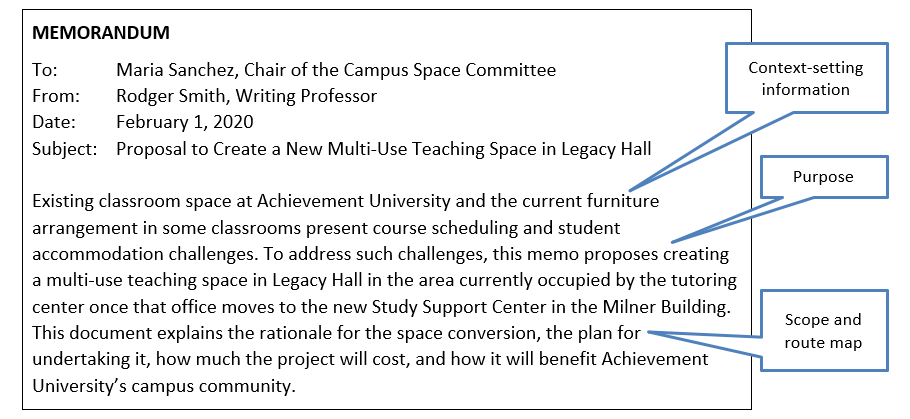
Although this introduction structure works for many types of lengthy and involved documents, such as memos, letters, essays, and topic proposals, in a short text, such as an email, a writer may sometimes only need to provide context and purpose for the message, as the example in Figure 3 illustrates.
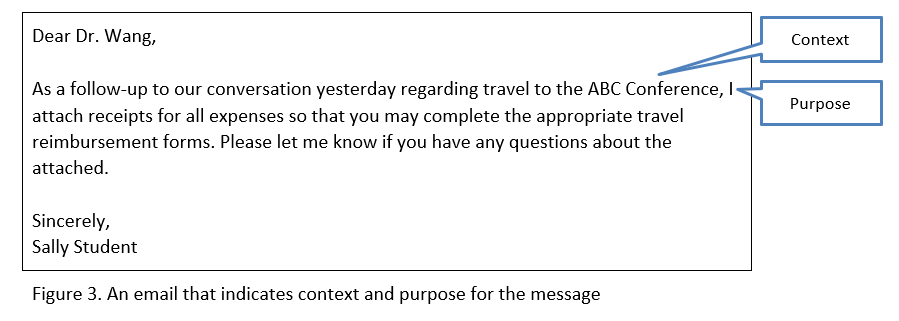
If you are not sure how much information to include in an introduction, think about what your readers will need to understand the rest of the document. You can then use the steps provided to structure your text.
Also be aware that a different introduction structure may be used in reports of research studies: this is the Create a Research Space (CaRS) Model identified by linguist John Swales in his 1990 book Genre Analysis: English in Academic and Research Settings. This type of introduction outlines a research study by supplying background on the topic of investigation, discussing gaps in the current research landscape, and identifying how the study addresses those gaps. In the CaRS introduction structure, these three items are identified as moves that help to contextualize the study for readers by explaining what motivated it. Using information adapted from the Writing and Communication Centre, University of Waterloo (n.d.a), Figure 4 explores these moves in greater detail.
Move 1: Establish a Research Territory – The research territory is the context required to understand and conduct the research. The goal is to explain the current state of scholarship in the field and say why the general research area is important.
Language for Establishing a Research Territory
- __________ has been extensively studied…
- Interest in __________ has been growing…
- Recent studies have focused on…
- __________ has become a major issue…
Move 2: Establish a Niche – The niche is the reason for the research. It helps readers understand how the study relates to the background provided by highlighting gaps/problems in current knowledge that justify or explain the need for further investigation.
Methods for Establishing a Niche
- Make a counter-claim (something is wrong)
- Indicate a gap (something is missing)
- Raise a question or make an inference (something is unclear)
- Continue a tradition (by adding something)
Language for Establishing a Niche
- Previous studies of __________ have not examined…
- Such studies are unsatisfactory because…
- One question that needs to be asked, however, is…
- Research on __________ has mostly been restricted to _________ so…
Move 3: Occupy the Niche – This step explains how the study responds to the need for further investigation identified in the previous step and lists specific research objectives, questions, or methods.
Strategies for Occupying the Niche
- Outline purpose(s) of the research
- List research questions or hypotheses
- Announce principal research findings
- Indicate the structure of the research process
Language for Occupying the Niche
- The purpose of this literature review is to…
- This study aims to…
- The evidence collected from this study demonstrates…
- This review outlines/examines…
Figure 4. An outline of the Create a Research Space introduction structure
Figure 5, an introductory paragraph adapted from the Writing and Communication Centre, University of Waterloo (n.d.a, “Example”), demonstrates the CaRS move structure at work in a research paper.
Figure 5. An introductory paragraph that follows the CaRS Model
You may encounter the CaRS introduction structure when reading journal articles, published papers that communicate research results and developments within scientific and other fields of study, or you may be asked to use the structure when reporting on your own research.
The Purpose and Structure of Conclusions
A conclusion brings unity to a document and should follow naturally from points that have been discussed previously in a text. For these reasons, do not introduce new ideas into a conclusion.
As is the case for an introduction, a conclusion may be one or more paragraphs long depending on the overall length and complexity of the accompanying document. Although conclusion components vary by document type, the following list presents general steps for constructing a conclusion. Note that authors may sometimes combine the steps when writing conclusions.
- Supply a summary of your main ideas or findings to reinforce the document’s key message. When writing an argumentative paper, reiterate your thesis.
- Discuss how your findings compare with other investigations, or point out the implications of your findings (in other words, say what the findings mean and why they are important)—if appropriate.
- Consider the limitations of your work or unanswered questions arising from your research—if appropriate.
- Make recommendations—if appropriate—suggesting possible directions for a project or for further research, for example.
At a minimum, a conclusion should contain a summary of the central points discussed in a document (step one), again to help unify ideas for readers and emphasize the principal message of the piece. Figure 6 exemplifies this conclusion structure.
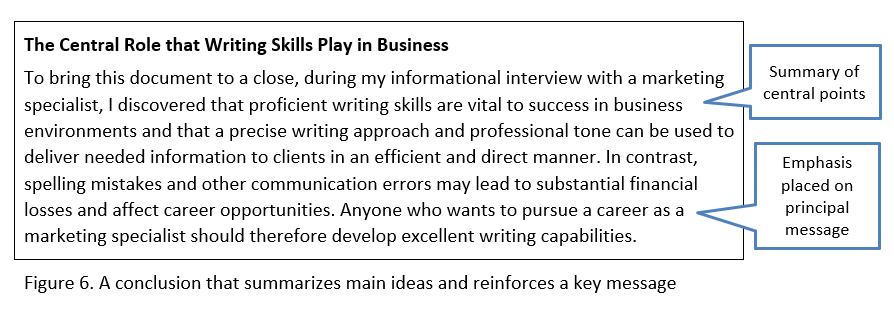
In comparison, documents that report on research studies oftentimes use all four conclusion steps. Journal articles, for example, typically contain all four steps. Figure 7, a conclusion from the computer science journal article “Machine Learning with Remote Sensing Data to Locate Uncontacted Indigenous Villages in Amazonia” (Walker & Hamilton, 2019, “Conclusions”) incorporates the four steps. Although you may not understand all the jargon in the extract—the specialized language or terminology used in a particular field of study or workplace environment—notice how the conclusion steps unfold in the sample.
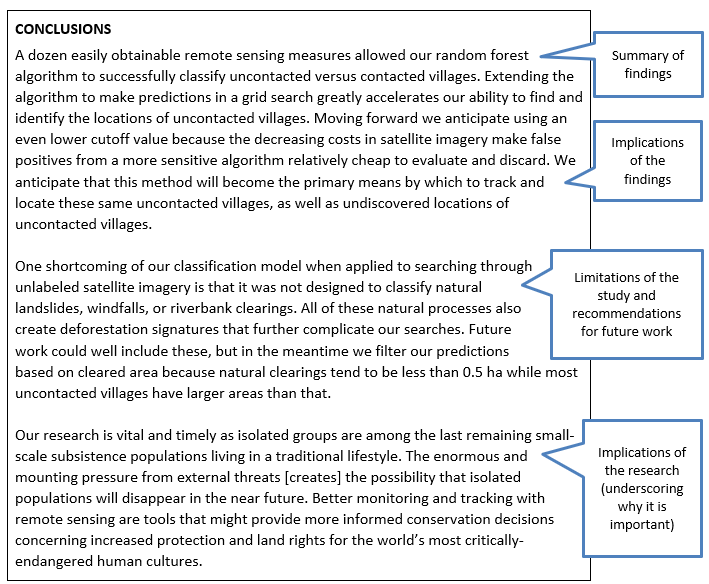
Conclusions that request action on the part of a reader may deviate to some degree from the list of elements presented by first reinforcing the key message of a document through a summary of main ideas before ending with a call to action, or a goodwill statement, or both. Figure 8 provides an example of this type of conclusion.
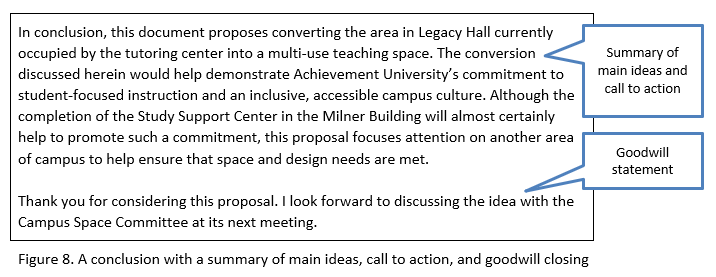
The purpose, audience, context, and genre for a document will suggest which conclusion structure is appropriate. If you are still unsure which structure to use in an assignment after considering these elements, discuss your questions with your instructor.
Cohesion and Coherence in Paragraphs
Although we have said that a document’s organizational structure operates at both the paragraph- and whole-text level, the unity of sentences and paragraphs does not happen by accident. Instead, writers must attend to cohesion and coherence in their documents to ensure they flow together in an easy-to-understand way. Cohesion refers to links within and among sentences that establish clear connections for readers (Min, n.d., para. 1), and it is achieved by combining words and punctuation so sentences and paragraphs logically and grammatically fit together. Coherence, or the overall correlation between ideas in a document, centers on the larger communicative facets of writing: for example, on composing topic sentences that relate back to a thesis statement; on developing an argument that clearly links evidence and reasons to viewpoints; and on integrating source material ethically and seamlessly into text (Min, n.d., para. 1). Cohesion and coherence should operate in tandem in a document so that readers can follow its logic without difficulty.
A Variety of Cohesive Devices
Practical devices, such as those presented here, can be used to achieve cohesion and coherence in writing.
- Transitions are linking words that connect ideas at the sentence or paragraph level.
- Purposeful repetition of key ideas and words underscores their importance to the meaning of a document.
- Parallel structure creates connections by maintaining the same grammatical structure throughout items in a sentence, series, list, or set of headings.
- A semicolon joins closely related ideas.
- A colon signals an association between the language that precedes the colon and the language that follows it.
- Dashes link and emphasize related ideas in a text.
- Parentheses surround explanatory text. Since the text in parentheses expounds upon something mentioned in the sentence, the parentheses indicate a link between sentence elements.
- A synonym is a word with the same meaning as another word. Synonyms can be used to emphasize important ideas without repeating individual words.
- An antonym is a word opposite in meaning to another word. Antonyms can be used when contrasting things, to establish a connection between differing ideas.
- A pronoun is used as a stand-in for a previously mentioned noun. An antecedent is the person, place, or thing (the noun) to which the pronoun refers.
Use an assortment of these devices to establish connections and infuse variety into your text.
Appositives as Cohesive Devices
An appositive is another cohesive device you may decide to employ. An appositive is a noun or a phrase containing a noun that adds identifying details to a previous noun. The following sentence contains an appositive: Marcus Riley, an innovative researcher, designed the experiment. Because the appositive supplies additional information about the noun, it establishes a link in the sentence and can be thought of as a cohesive device.
Stylistic Techniques as Cohesive Devices
Stylistic techniques can also be used to establish connections within sentences and paragraphs. The following list, adapted from Schall (2014b) under a CC-BY-NC-SA license, explains this point in further detail.
- Link the subjects of juxtaposed sentences.
- Example: To heat the sample, tungsten-halogen lamps are used below and above the fused silica tube. These lamps contain a tungsten filament and bromide gas inside a quartz bulb. By resistive heating alone, the lamps can attain temperatures of 300°C to 400°
- Link the end of one sentence to the beginning of the next sentence.
- Example: The film is not completely oriented in a single direction, and the system includes a number of entanglements. These entanglements become frozen into position as the film crystallizes.
- Link sentences through implicit similarity, repetition, contrast, or causality.
- Example: When a subject views an object initially as a circle, that image becomes imprinted on the brain. Even when the eye and brain can distinguish an ellipse from the circle, memory tricks the subject into seeing a circle.
- Example: The addition of oxygen promotes soot formation, particularly at low temperatures. On the other hand, oxygen also removes aromatic rings and active intermediates by oxidation, thus suppressing soot formation at high oxygen concentrations.
- Example: Because the wire is flexible, the sonde can rely on its own weight to pull it down the hole, essentially doing a free fall. Therefore, the sonde tends to get stuck easily in highly deviated holes.
- Establish a particular order and then follow through with that order.
- Example: Norris describes three forms of exit morphology. In the first form, development has spread to both sides of the intersecting road, but is still limited to one side of the interstate. In the second form, development exists on both sides of the highway. In the third form, which Norris labels full development, services are located along both sides of the intersecting roads and along ancillary feeder roads.
These stylistic techniques can be used to create sentence variety and compelling connections in written text.
Practice identifying the various cohesive devices discussed by underlining or circling them in the following text, which is adapted from McCulloch (2012, pp. 56-57) under a CC-BY license. In addition, identify the types of cohesive devices used by writing your answers in the margin.
The problem with excessive quoting in writing is that, unless it is done skillfully, quoting can limit the extent to which ideas can be re-contextualized for a new purpose. Writers should not simply reproduce and report source material; instead, they should reshape it to fit their own unique arguments. This re-shaping can be accomplished more effectively through paraphrasing or summarizing than by quoting directly. Many teachers thus prefer that students paraphrase sources when possible. Quoting is not always discouraged, however. Citation norms, including the amount of direct quotation that is considered acceptable, vary from discipline to discipline (Hyland, 1999), and composition scholars routinely analyze how writers in various fields employ quotations when producing texts.
Lack of source evaluation can also be problematic in student writing. A common complaint about novice writers is that they attribute too much authority to their sources and fail to take a sufficiently evaluative stance toward them (Pecorari, 2003; Petrić, 2007; Thompson, 2005). As a result, learners may produce texts that rely heavily on others’ viewpoints rather than producing cogent arguments of their own.
Use Cohesive Devices Carefully
When using any of the cohesive devices discussed, the key is to think carefully about how they help readers follow a text and grasp its meaning. In the case of transitions, for instance, select appropriate ones that convey your intended message. Surprisingly, a one-word transition can change the meaning of a text, as the following examples demonstrate.
Do-It-Right Power estimated the solar conversion would take eight weeks. Consequently, the firm was hired to complete the project.
Do-It-Right Power estimated the solar conversion would take eight weeks. Regardless, the firm was hired to complete the project.
In addition, transitions should not be inserted artificially into a document in an attempt to create linkages; if the relationship between ideas is already clear, transitions are not necessary. Consider, for instance, the examples in Figure 9, which are adapted from Babin et al. (2018, p. 70), under a CC-BY-NC-SA license: the first example contains an excessive number of transitions, some of which confuse meaning, while the second uses just enough transitions to aid reader understanding.
Example One: Uses Too Many Transitions
The Impressionist painters of the late 19th century are well known for their visible brush strokes, for their ability to convey a realistic sense of light, and for their everyday subjects portrayed in outdoor settings. In spite of this fact, many casual admirers of their work are unaware of the scientific innovations that made it possible for this movement in art to take place. Then, in 1841, an American painter named John Rand invented the collapsible paint tube. To illustrate the importance of this invention, pigments previously had to be ground and mixed in a fairly complex process that made it difficult for artists to travel with them. For example, the mixtures were commonly stored in pieces of pig bladder to keep the paint from drying out. In addition, when working with their palettes, painters had to puncture the bladders, squeeze out some paint, and then mend the bladders again to keep the rest of the paint mixtures from drying out. Thus, Rand’s collapsible tube freed the painters from these cumbersome and messy processes, allowing artists to be more mobile and to paint in the open air.
Example Two: Uses Subtle Transitions to Encourage Reader Understanding
In comparison to the first example in Figure 9, the second paragraph uses transitions to effectively sustain momentum and flow in order to facilitate easy reading.
When used conscientiously, pronouns (e.g., she, he, it, they, them, it, their) can also establish connections in writing. To help readers understand the connections, pronouns (except I) usually need clear antecedents, which means they must refer to individuals, places, or things that have already been specifically mentioned, and they must agree with their antecedents in gender and number. In the following example, the company (the antecedent) is a singular entity, which means that a singular pronoun must be used when referring to it.
The company established new employee rules. They attempted to stem workplace absences. → Incorrect
The company established new employee rules. It attempted to stem workplace absences. → Correct
The pronouns you and your should also be used with care since they are appropriate in some types of writing (for example, teaching materials), but not in others. As a guideline, use these pronouns to refer to a specific reader directly rather than to people in general (the latter use signals an informal style of writing). The following example uses the pronoun your to refer to a specific reader directly: Bill, please send me your expense report by noon today.
Also be aware of expletives and the effect they can have on a text and its readers. An expletive is a non-specific word, placed at the beginning or in the middle of a sentence, that fills the position of another word. There, this, and it are commonly used as expletives. In the following example, the expletive can be removed by placing the subject (the thing or person performing the action or being described) at the beginning of the sentence.
There were many concerns expressed by meeting attendees. → Sentence with an expletive
Meeting attendees expressed many concerns. → Reformulated sentence
Since expletives add unnecessary words to sentences and can confuse readers, avoid them when possible.
Use the guidance provided in this chapter to identify a readability/concision/cohesion issue in the following text, which is adapted from Smith et al. (2018, pp. 135-136). You will find several instances of the same issue in the text.
What effect does the issue have on you as a reader?
Well-Organized Paragraphs Encourage Reader Engagement
Remember that paragraphs exist to help readers. Use the guidelines in this chapter to help ensure that your writing is clear, readable, and easy to navigate.
Activity A: Analyze Style Characteristics
To gain familiarity with the style characteristics common to research writing in your chosen career field, including conventions for paragraph construction, text organization, and source integration, locate two journal articles or formal reports from that field. A librarian can help you find documents that align with your interests. Afterwards, use the guidance below to analyze the documents. The first two-page text is adapted from Ravaei et al. (2020), while the second text is adapted from Roux et al. (2020).
Examples from UCLA Library under CC-BY-NC-SA license.
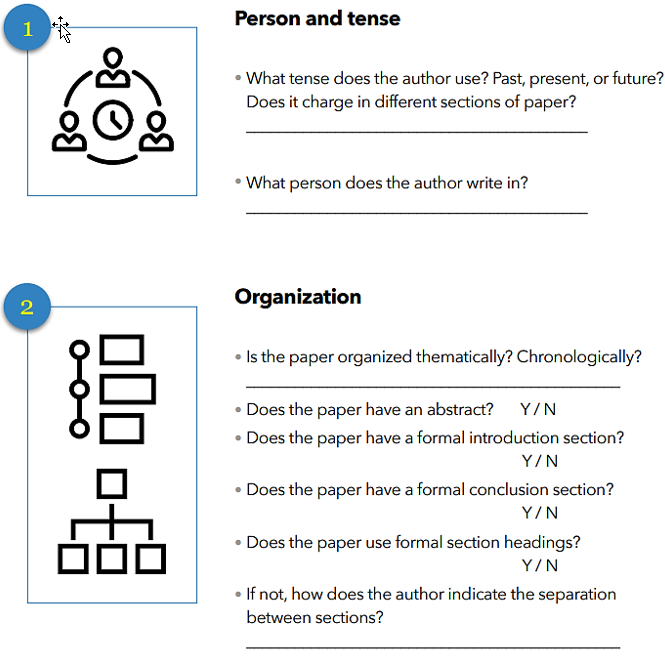
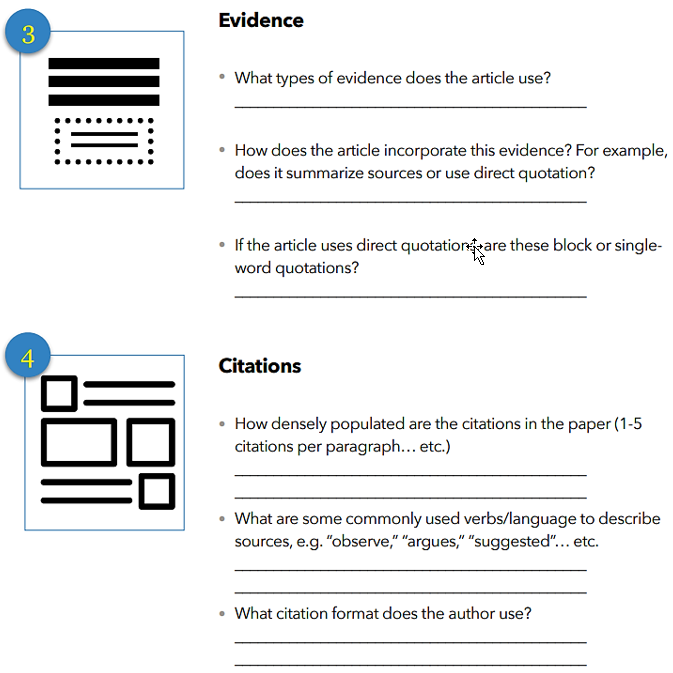
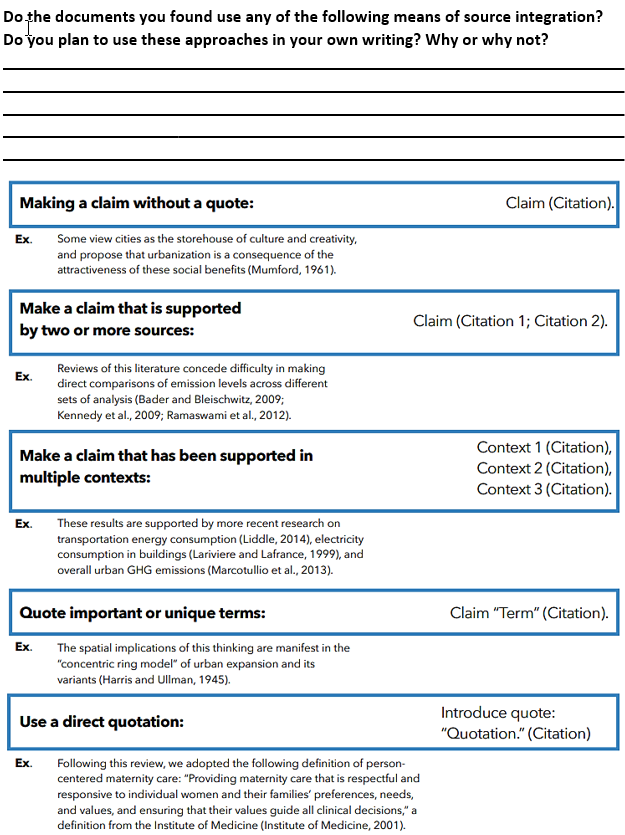
What conclusions can you draw about research writing in your chosen career field as a result of completing this activity?
Activity B: Create a Checklist to Use When Writing and Revising Paragraphs
Read the following handouts.
- “10 Common Grammatical Errors and Conventions in Academic Writing” (Robert Gillespie Academic Skills Centre, University of Toronto Mississauga, n.d.) at https://www.utm.utoronto.ca/asc/sites/files/asc/public/shared/pdf/tip_sheets_writing/10GrammarErrors_web_v2.pdf
- “Parallelism” (Writing and Communication Centre, University of Waterloo, n.d.c) at https://uwaterloo.ca/writing-and-communication-centre/sites/ca.writing-and-communication-centre/files/uploads/files/parallelism_0.pdf
Draw upon the handout information to create a checklist to use when writing and revising paragraphs. Be prepared to discuss your checklist items in class.
Activity C: Create a List of Linking Expressions
Match the groups of linking words and phrases with their meanings to produce a list of expressions you can use in your papers.
Meanings: summary, cause/effect, emphasis, concession, addition, generalization, sequence, elaboration, illustration, comparison, contrast
| Meanings of the Linking Expressions | Linking Expressions |
|---|---|
| Again, also, and, and then, moreover, another, equally important, finally, additionally, further, furthermore, apart from this, in addition, nor, too, what is more, so too, not only … but also | |
| Accordingly, as a result, hence, so, thus, since, consequently, therefore, as a consequence, for this reason, this leads to, because of this, if … then | |
| In the same way, similar to, likewise, similarly, along the same lines, in comparison, comparatively | |
| Granted, naturally, of course, admittedly, to be sure, although it is true, if, in that case, provided that | |
| Although, however, in contrast, nevertheless, on the contrary, otherwise, regardless, yet, but, conversely, despite, even though, nonetheless, on the other hand, whereas | |
| Actually, by extension, in other words, that is, to put it another way, to put it succinctly, ultimately, namely, or rather, this means, to be more precise | |
| Certainly, indeed, in fact, moreover, of course, chiefly, especially, importantly, in particular, mainly, notably, particularly | |
| As a rule, for the most part, generally, in general, normally, on the whole, in most cases, usually, clearly, naturally, obviously, surely | |
| For example, for instance, indeed, in fact, in other words, in short, namely, specifically, after all, to illustrate, consider, to take a case in point, such as, as follows | |
| Altogether, finally, in brief, in conclusion, in short, in summary, on the whole, therefore, in sum, to sum up, to summarize, to conclude, overall | |
| Afterward, again, before, eventually, finally, last, lately, meanwhile, next, subsequently, then, at first, first, firstly, initially, lastly, prior to, now, presently, simultaneously, since, so far, soon, thereafter, when |
Homework: Prepare a Memo that Focuses on Course Outcomes
Consider your current skill level in relationship to the outcomes for your writing course(s), and address the questions listed below in a memo. Use the guidelines in this chapter to organize your paragraphs and to ensure they are cohesive and coherent, and remember to cite and reference any outside sources of information you use.
- Which course outcomes do you feel well prepared to meet? How and where did you acquire the knowledge/skills related to these outcomes—past writing courses, other courses with writing requirements, or on-the-job experience?
- Which course outcomes will present the most challenges for you, and why? What, specifically, can you do to meet the challenges of these course outcomes?
Consult the “Writing Print Correspondence” chapter of this textbook for guidance when writing and formatting your memo.
After you have drafted your memo, use the checklist you developed in Activity B to revise your work.
References
Babin, M., Burnell, C., Pesznecker, S., Rosevear, N., Wood, J. (2018). Transitions: Developing relationships between ideas. In M. Gagich, E. Zickel, A. Lloyd, C. Morgan, J. Lanning, R. Mustafa, S.M. Lacy, W. Breeze, & Y. Bruce (Eds.), In practice: A guide to rhetoric, genre, and success in first-year writing (pp. 68-72). MSL Academic Endeavors. License: CC-BY 4.0. https://pressbooks.ulib.csuohio.edu/csu-fyw-rhetoric/
Lambert, R. (2019a). Sentence types. Colorado School of Mines Writing Center. https://www.mines.edu/otcc/wp-content/uploads/sites/303/2019/12/otccsentencetypeslesson.pdf
Lambert, R. (2019b). Sentence type practice. Colorado School of Mines Writing Center. https://www.mines.edu/otcc/wp-content/uploads/sites/303/2019/12/otccsentencetypeexercises.pdf
Last, Suzan (2019). Technical writing essentials: introduction to professional communication in the technical fields. License: CC-BY-SA-3.0. Retrieved from https://pressbooks.bccampus.ca/technicalwriting/
McCulloch, S. (2012). Citations in search of a purpose: Source use and authorial voice in L2 student writing. International Journal for Educational Integrity, 8(1), 55-69. License: CC-BY 4.0. http://clok.uclan.ac.uk/21755/
Min. Y.K. (n.d.). ESL: Coherence and cohesion. University of Washington Bothell. https://www.uwb.edu/wacc/for-students/eslhandbook/coherence
Ravaei, K., Harper, T., & Roux, S. (2020). Reading for writing style. WI+RE: Writing Instruction + Research Education. License: CC-BY-NC-SA 3.0. https://uclalibrary.github.io/research-tips/assets/handouts/reading-for-style-d2.pdf
Robert Gillespie Academic Skills Centre, University of Toronto Mississauga. (n.d.). 10 common grammatical errors and conventions in academic writing. https://www.utm.utoronto.ca/asc/sites/files/asc/public/shared/pdf/tip_sheets_writing/10GrammarErrors_web_v2.pdf
Roux, S., Harper, T., & Meyer, C. (2020). Citation integration. WI+RE: Writing Instruction + Research Education. License: CC-BY-NC-SA 3.0. https://uclalibrary.github.io/research-tips/assets/handouts/citation-integration-final.pdf
Schall, J. (2014a). Topic sentences: Effective technical writing in the information age. Penn State College of Earth and Mineral Sciences. License: CC-BY-NC-SA. https://www.e-education.psu.edu/styleforstudents/c1_p4.html
Schall, J. (2014b). Writing paragraphs that flow: Effective technical writing in the information age. Penn State College of Earth and Mineral Sciences. License: CC-BY-NC-SA. https://www.e-education.psu.edu/styleforstudents/c1_p3.html
Smith, A.J., Clutton, R.E., Lilley, E., Hansen, K.E.A., & Brattelid, T. (2018). PREPARE: Guidelines for planning animal research and testing. Laboratory Animals, 52(2), 135-141. License: CC-BY-NC. doi: 10.1177/0023677217724823
Student Academic Success Services, Queen’s University. (2018). Sentence fragments, comma splices, and run-ons. http://sass.queensu.ca/wp-content/uploads/2019/04/Fragments.pdf
Swales, J.M. (1990). Genre analysis: English in academic and research settings. Cambridge University press.
Sweetland Center for Writing, University of Michigan. (2020). What is a run-on sentence, and how do I fix it? https://lsa.umich.edu/content/dam/sweetland-assets/sweetland-documents/WritingGuides/WhatIsaRunOnSentence.pdf
Walker, R.S., & Hamilton, M.J. (2019). Machine learning with remote sensing data to locate uncontacted indigenous villages in Amazonia. Peer J Computer Science, Article 5:e170. License: CC-BY 4.0. http://doi.org/10.7717/peerj-cs.170
Writing and Communication Centre, University of Waterloo. (n.d.a). CaRS model: Create a research space. License: CC-BY-SA 4.0. https://uwaterloo.ca/writing-and-communication-centre/cars-model-create-research-space
Writing and Communication Centre, University of Waterloo. (n.d.b). Flow. License: CC-BY-SA 4.0. https://uwaterloo.ca/writing-and-communication-centre/flow
Writing and Communication Centre, University of Waterloo. (n.d.c). Parallelism. License: CC-BY-SA 4.0. https://uwaterloo.ca/writing-and-communication-centre/sites/ca.writing-and-communication-centre/files/uploads/files/parallelism_0.pdf
